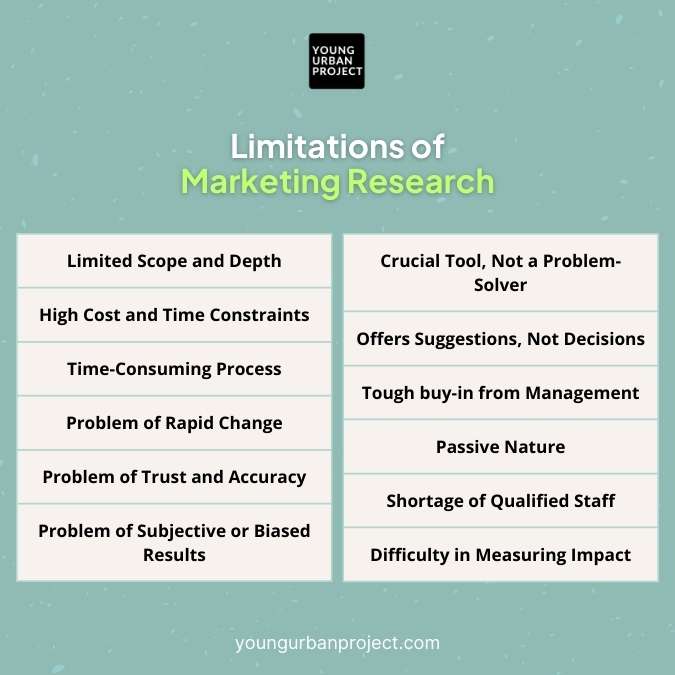Marketing research is a critical component in developing effective marketing strategies. It helps businesses understand their target audience, identify market trends, and make data-driven decisions.
However, like any tool, marketing research has its limitations. In this blog post, we will explore the key limitations of marketing research, providing insights and real-world examples to help you navigate these challenges effectively.
Table of Contents
What is Marketing Research?
Before diving into the limitations, it’s important to understand what marketing research entails. Marketing research involves the systematic collection, analysis, and interpretation of data related to marketing activities. It aims to provide insights that can help businesses understand market dynamics, customer behaviour, and competitive landscapes.
Types of Marketing Research
- Primary Research: Data collected directly from the source through surveys, interviews, focus groups, and observations.
- Secondary Research: Analysis of existing data from reports, studies, and market research databases.
Top 12 Limitations of Marketing Research

1. Limited Scope and Depth
Scope Limitations of marketing research
Marketing research often focuses on specific aspects of the market or customer behavior, which can limit its scope. For example, a survey conducted to understand customer preferences for a particular product might not capture broader market trends or external factors influencing customer decisions.
Example: A company conducting a survey on customer satisfaction with a new smartphone model may obtain valuable feedback on features and usability. However, the research might not reveal broader industry trends, such as shifts in consumer preferences towards eco-friendly technology.
Depth Limitations of marketing research
Some marketing research methods may not provide in-depth insights into complex consumer behavior. For instance, while surveys can capture quantitative data, they may not fully uncover the reasons behind customer preferences or the emotional drivers influencing their decisions.
Example: A survey indicating that 60% of respondents prefer a particular brand may not explain why they feel this way. In-depth interviews or focus groups might be needed to understand the underlying motivations.
2. High Cost and Time Constraints
Conducting comprehensive marketing research can be expensive, especially when utilizing advanced methods or large sample sizes. Costs can include data collection, analysis, and reporting.
For Example: Implementing a nationwide survey with a large sample size requires significant resources, which may not be feasible for small businesses or startups.
Also Read: Advantages and Disadvantages of Marketing Research
3. Time-Consuming Process
Marketing research can be time-consuming, from designing research instruments to collecting and analyzing data. This process involves many important steps, and there are no shortcuts in MR. For businesses relying on remote jobs, efficient research strategies are crucial to avoid delays in decision-making and maintain agility in a fast-changing market.
Example: A company that needs to launch a new product on a close deadline might find that the time required for extensive market research delays their go-to-market strategy.
4. Problem of Rapid Change
Marketing research often struggles to stay relevant due to the rapid pace of technological advancements and changing consumer preferences. As new technologies like AI emerge and market conditions shift, research findings can quickly become outdated.
Economic changes and new competitors can also disrupt the market, making it challenging for research to keep up. To address these issues, marketing research must be continually updated and adaptable to reflect the latest trends and dynamics.
5. Problem of Trust and Accuracy
Ensuring trust and accuracy in marketing research is challenging due to several factors. The reliability of research depends on the quality of the data and its sources; data from unreliable or biased sources can lead to incorrect conclusions. Response bias, where respondents provide inaccurate or exaggerated answers, can further skew results.
Additionally, sampling issues arise when a sample does not accurately represent the larger population, leading to misleading findings. Researcher bias can also influence how data is interpreted, affecting objectivity.
Furthermore, data privacy and security concerns are crucial, as mismanagement or breaches can undermine trust in the research process. To address these challenges, it is essential to use robust methodologies, ensure transparency in reporting, and implement strong measures to protect data and minimize bias.
Also Read: Objectives of Marketing Research
6. Problem of Subjective or Biased Results
Marketing research can suffer from subjective or biased results, affecting its accuracy and reliability. Researcher bias, where personal interests or beliefs influence the interpretation of data, can skew findings. Similarly, poorly designed surveys or interview questions can lead respondents toward certain answers, distorting the data.
Response bias, where participants provide socially desirable answers instead of honest ones, also compromises objectivity. To reduce these issues, it’s important to use unbiased research methods, design studies carefully, and ensure transparency throughout the process.
7. Marketing Research is a Crucial Tool, Not a Problem-Solver
Marketing research is crucial for gaining insights and guiding decisions, but it doesn’t solve problems by itself. Instead, it provides valuable information that helps address challenges. The effectiveness of research depends on using reliable sources and applying the findings correctly. Even top-notch research won’t help if its results are ignored or misunderstood.
Example: Imagine a company with falling sales. Market research might uncover changes in customer preferences or product weaknesses. This information is essential, but it doesn’t fix the sales problem on its own. The company needs to act on these insights—like updating their product or tweaking their marketing strategy—to effectively tackle the issue. Without applying research insights in a practical way, the research alone won’t solve the problem.
Also Read: Types of Marketing Research
8. Marketing Research Offers Suggestions, Not Decisions
Marketing research provides valuable insights and suggestions, but it doesn’t make decisions for you. Think of research as a guide that helps you understand market trends, customer preferences, and potential challenges. It collects and analyzes data to offer recommendations, but it’s up to you to make the final decisions based on this information.
Example: Imagine you’re considering launching a new product. Marketing research might reveal that there is strong demand for a feature you’re planning to include. While this insight suggests that the feature could be successful, it doesn’t dictate your exact course of action. You’ll need to weigh this information alongside other factors, such as budget, competition, and strategic goals, to make the final decision on whether to proceed with the product launch.
9. Challenges getting buy-in of Management
Marketing researchers provide valuable insights and recommendations to help executives make informed decisions. However, some management/executives are hesitant to fully embrace these suggestions. They worry that relying on research might expose them to risks if the recommendations lead to unfavorable outcomes, potentially affecting their job security and status.
Example: For instance, a major retail chain that was experiencing declining sales received research recommendations to change its product line to better align with new consumer trends. Some executives were initially reluctant to follow this advice due to fears of failure and personal risk. However, by carefully implementing the research-based recommendations alongside their own market knowledge, the company was able to successfully update its product offerings and improve sales.
10. Passive Nature of Marketing Research
One of the underrated limitations of Marketing research is its passive nature. This means it doesn’t take action on its own but provides information and insights. Sometimes, this can make the research seem too basic or even inaccurate when applied to business decisions. The conclusions from marketing research might be based on assumptions or incomplete data, rather than solid facts.
The real value of marketing research depends on how well marketing executives use it. The research itself doesn’t solve problems; it only offers guidance and suggestions. Executives need to actively interpret and apply these insights to make effective decisions.
In short, marketing research helps by pointing out possible directions, but it requires thoughtful use by executives to be truly useful.
Also Read: Scope of Marketing Research
11. Shortage of Qualified professionals
A significant challenge in marketing research is the shortage of qualified marketing research talent. Finding skilled professionals who can effectively conduct and interpret research is often difficult. Without the right expertise, research may lack depth and accuracy, leading to less reliable insights.
This shortage can impact the quality of research and, consequently, the decision-making process. Investing in training and development or seeking experienced professionals is crucial to overcoming this challenge and ensuring high-quality marketing research.
12. Difficulty in Measuring Research Impact
Another one of critical limitations of marketing research is the difficulty in measuring the direct impact of research findings on business outcomes. While research provides valuable insights, it can be challenging to quantify how these insights translate into tangible results like increased sales or improved customer satisfaction.
This lack of clear measurement can make it hard to assess the effectiveness of research and justify the investment in it. Companies can address this by setting specific, measurable objectives for research projects and tracking relevant performance metrics to better understand the impact of their research efforts.

Enroll Now: Advanced Product Marketing Course
Conclusion
Marketing research is crucial for making informed decisions, but it comes with limitations. It can be expensive and time-consuming, and findings may quickly become outdated due to rapid market changes. Additionally, issues such as accuracy and bias can affect the reliability of the results.
While marketing research offers valuable insights and suggestions, it does not solve problems or make decisions for you. It’s important to use research as a guide and apply its findings carefully, along with your own judgment and experience, to make better decisions.
FAQ About Limitation of Marketing Research
What are the main limitations of marketing research?
Marketing research has several key limitations, including high costs, time demands, and issues with data accuracy. These challenges can affect the quality and usefulness of the research.
How do cost and time constraints impact marketing research?
High costs and long timelines can limit the extent of marketing research. Expensive and time-consuming processes can delay decisions and be too costly for smaller businesses, reducing their ability to perform thorough research.
What problems can arise with the accuracy of marketing research data?
Accuracy issues can come from biased sources, participant dishonesty, or errors in sampling. These problems can lead to unreliable results and affect the overall credibility of the research.
How does the fast pace of industry change affect marketing research?
Rapid technological advances and shifting consumer preferences can quickly make research findings outdated. This fast pace makes it hard to keep research relevant and up-to-date. This is a reason why marketing research needs to be looked at as an ongoing effort, and not a one-time effort.
Why is it important to recognize the limitations of marketing research?
Knowing the limitations helps businesses interpret research results correctly and manage expectations. It ensures that research is used as a helpful guide rather than a final answer, leading to better decision-making and planning.

